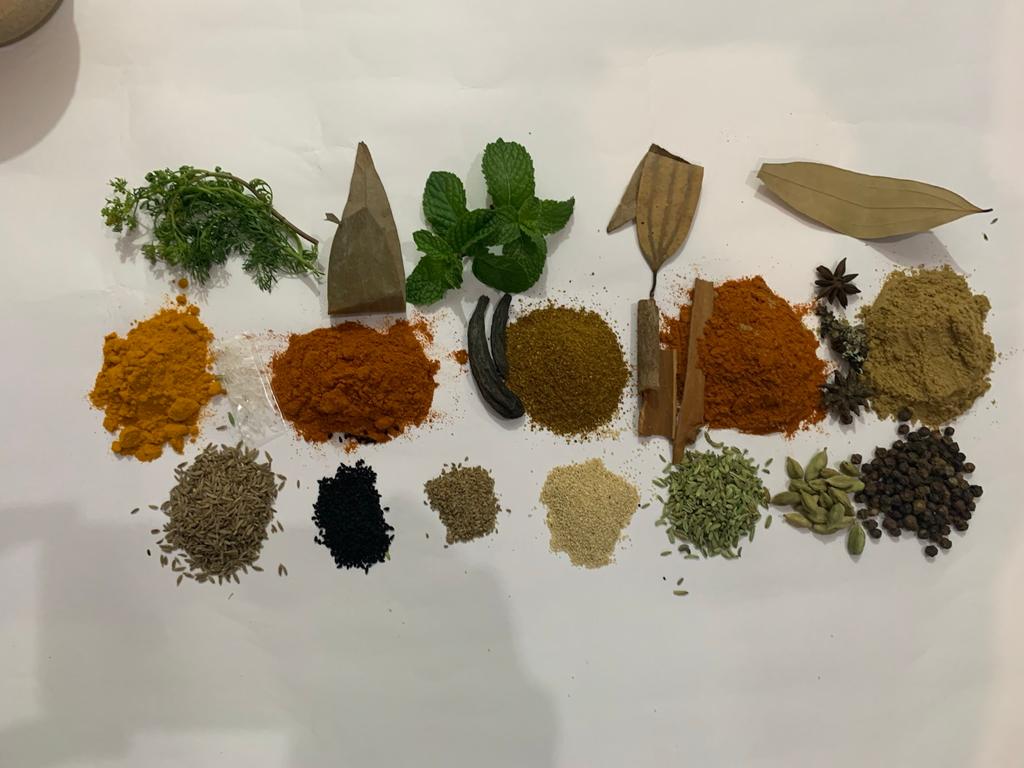A spice is a seed, fruit, root, bark, or other plant substance primarily used for flavoring or coloring food. Spices are distinguished from herbs, which are the leaves, flowers, or stems of plants used for flavoring or as a garnish. Spices are sometimes used in medicine, religious rituals, cosmetics or perfume production. For example, vanilla is commonly used as an ingredient in fragrance manufacturing.

Bharatha is the Nation rich with Spices and Medicinal herbs. We are here presenting the few and selected natural spices.
The word spice originated in Middle English which came from the Old French words espece, espis(c)e, and espis(c)e. According to the Middle English Dictionary, the Old French words came from Anglo-French spece; according to Merriam Webster, the Old-French words came from Anglo-French espece, and espis. Both publications agree that the Anglo-French words derived from Latin species. Middle English spice had its first known use as a noun in the 13th century.
History of the spices,
The spice trade developed throughout the Indian subcontinent by at earliest 2000 BCE with cinnamon and black pepper, and in East Asia with herbs and pepper. The Egyptians used herbs for mummification and their demand for exotic spices and herbs helped stimulate world trade. By 1000 BCE, medical systems based upon herbs could be found in China, Korea, and India. Early uses were connected with magic, medicine, religion, tradition, and preservation.
It functions as below,
Spices are primarily used as food flavoring or to create variety. They are also used to perfume cosmetics and incense. At various periods, many spices have been believed to have medicinal value. Finally, since they are expensive, rare, and exotic commodities, their conspicuous consumption has often been a symbol of wealth and social class.
It is often claimed that spices were used either as food preservatives or to mask the taste of
Classification of Spices are as follows.
• Fennel, mustard, nutmeg, and black pepper as Seeds,
• Cayenne pepper and Chimayo pepper as Fruits,
• Mace (part of nutmeg plant fruit) as Arils
• True Cinnamon and cassia as Barks.
For ground spices, to grind a whole spice, the classic tool is mortar and pestle. Less labor-intensive tools are more common now: a microplane or fine grater can be used to grind small amounts; a coffee grinder is useful for larger amounts. A frequently used spice such as black pepper may merit storage in its own hand grinder or mill.
Spices have been claimed to have health effects during both ancient and current times; for example, in 2017, the Washington Post said spices put “a natural pharmacy in your kitchen”. The supposed health benefits include antioxidant and anti-inflammatory effects, and benefits towards certain diseases. A 2019 systematic review looked at studies of 25 spices and concluded that there is not enough evidence yet to support these supposed benefits,
Here is the List of Spices
- allspice (Pimenta dioica)
- angelica (Angelica archangelica)
- anise (Pimpinella anisum)
- asafoetida (Ferula assa-foetida)
- bay leaf (Laurus nobilis)
- basil (Ocimum basilicum)
- bergamot (Monarda species)
- black cumin (Nigella sativa)
- black mustard (Brassica nigra)
- black pepper (Piper nigrum)
- borage (Borago officinalis)
- brown mustard (Brassica juncea)
- burnet (Sanguisorba minor and S. officinalis)
- caraway (Carum carvi)
- cardamom (Elettaria cardamomum)
- cassia (Cinnamomum cassia)
- catnip (Nepeta cataria)
- cayenne pepper (Capsicum annuum)
- celery seed (Apium graveolens, variety dulce)
- chervil (Anthriscus cerefolium)
- chicory (Cichorium intybus)
- chili pepper (Capsicum species)
- chives (Allium schoenoprasum)
- cicely (Myrrhis odorata)
- cilantro (Coriandrum sativum)
- cinnamon (Cinnamomum verum)
- clove (Syzygium aromaticum)
- coriander (Coriandrum sativum)
- costmary (Tanacetum balsamita)
- cumin (Cuminum cyminum)
- curry
- dill (Anethum graveolens)
- fennel (Foeniculum vulgare)
- fenugreek (Trigonella foenum-graecum)
- filé (Sassafras albidum)
- ginger (Zingiber officinale)
- grains of paradise (Aframomum melegueta)
- holy basil (Ocimum tenuiflorum)
- horehound (Marrubium vulgare)
- horseradish (Armoracia rusticana)
- hyssop (Hyssopus officinalis)
- lavender (Lavandula species)
- lemon balm (Melissa officinalis)
- lemon grass (Cymbopogon citratus)
- lemon verbena (Aloysia citrodora)
- licorice (Glycyrrhiza glabra)
- lovage (Levisticum officinale)
- mace (Myristica fragrans)
- marjoram (Origanum majorana)
- nutmeg (Myristica fragrans)
- oregano (Origanum vulgare)
- paprika (Capsicum annuum)
- parsley (Petroselinum crispum)
- peppermint (Mentha ×piperita)
- poppy seed (Papaver somniferum)
- rosemary (Salvia rosmarinus)
- rue (Ruta graveolens)
- saffron (Crocus sativus)
- sage (Salvia officinalis)
- savory (Satureja hortensis and S. montana)
- sesame (Sesamum indicum)
- sorrel (Rumex species)
- star anise (Illicium verum)
- spearmint (Mentha spicata)
- tarragon (Artemisia dracunculus)
- thyme (Thymus vulgaris)
- turmeric (Curcuma longa)
- vanilla (Vanilla planifolia and V. tahitensis)
- wasabi (Eutrema japonicum)
- white mustard (Sinapis alba)
Information Source: